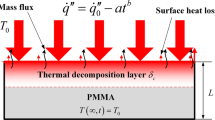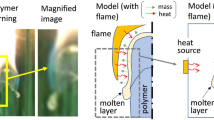Abstract
This contribution presents an alternative methodology to predict ignition of solid under increasing-steady heat flux, which may be irradiated from the smoke layer with time-dependent temperature. An approximate analytical solution, using ignition temperature criterion, is proposed and two typical heating conditions, linear- and t2-steady heat fluxes, are emphasized. The critical increasing rate of heat flux and the critical transition time, guaranteeing non-ignition in the first stage, are quantitatively assessed. Two explicit ignition time correlations are derived for low and high heat fluxes in the second stage, and the thresholds separating the application regimes of the two correlations are also provided. PMMA (polymethyl methacrylate) and a previously developed numerical model are employed to validate the reliability of the analytical model and the accuracies of the approximations used. The results show that under the designed four sets of increasing-steady heat fluxes, the analytically predicted surface temperatures and ignition times match the simulation results well. Using the calculated ignition time, the linear dependency of ignition time on the squared critical energy is also found valid in current study. Meanwhile, the effect of critical temperature on ignition time predictions is quantitatively examined by parametric study.










Similar content being viewed by others
Abbreviations
- A :
-
Constant in ignition time correlation
- a :
-
Constant in heat flux (HF) expression (W m−2 s−b)
- B :
-
Constant in ignition time correlation
- b :
-
Constant in HF expression
- C :
-
Constant in ignition time correlation
- C P :
-
Heat capacity of solid (J g−1 K−1)
- \(C_{{\text{g}}}\) :
-
Heat capacity of gas (J g−1 K−1)
- e :
-
Euler number
- \(\Delta H_{{\text{v}}}\) :
-
Heat of decomposition (J g−1)
- h c :
-
Convection heat transfer coefficient/W m−2 K−1
- k :
-
Thermal conductivity/W m−1 K−1
- L :
-
Thickness of computation volume (m)
- \(\dot{m}^{\prime\prime}\) :
-
Mass flux (g m−2 s−1)
- \(\dot{q}^{\prime\prime}\) :
-
Transient HF (W m−2)
- \(\dot{q}_{{\text{c}}}^{{\prime \prime }}\) :
-
Constant HF (W m−2)
- \(R\) :
-
Ideal gas constant (J mol−1 K−1)
- \(S_{{\text{v}}}\) :
-
Pyrolysis rate (s−1)
- t :
-
Time (s)
- T :
-
Temperature (K)
- x :
-
Spatial coordinate (m)
- \(Z\) :
-
Pre-exponential factor (s−1
- \(\alpha\) :
-
Thermal diffusivity (m2 s−1)
- \(\varepsilon\) :
-
Emissivity
- \(\theta\) :
-
Relative temperature (K)
- \(\xi\) :
-
Non-dimensional spatial parameter
- \(\rho\) :
-
Density (gm−3)
- \(\sigma\) :
-
Stefan–Boltzmann constant (W m−2 K−4)
- \(\tau\) :
-
Relative time/s
- \(\varphi\) :
-
Non-dimensional time
- 1:
-
Linear-steady HF
- 2:
-
t2-steady HF
- cri:
-
Critical value
- ig:
-
Ignition
- t:
-
Transition time
- thr:
-
Threshold value
- 0:
-
Initial and ambient conditions
References
Walton WD, Thomas PH, Ohmiya Y. Estimating temperatures in compartment fires. In: Hurley MJ, editor. SFPE handbook of fire protection engineering. New York: Springer; 2016. p. 996–1023.
Babrauskas V, Peacock RD, Reneke PA. Defining flashover for fire hazard calculations Part II. Fire Safety J. 2003;38:613–22.
Gong J, Wang D, Shi L, Liu X, Chen Y, Zhang G. Experimental study on the smoke temperature evolution in a polyethylene (PE)-lined compartment on fire. J Therm Anal Calorim. 2020;140:1907–17.
Chen CJ, Hsieh WD, Hu WC, Lai CM, Lin TH. Experimental investigation and numerical simulation of a furnished office fire. Build Environ. 2010;45:2735–42.
Byström A, Cheng X, Wickström U, Veljkovic M. Full-scale experimental and numerical studies on compartment fire under low ambient temperature. Build Environ. 2012;51:255–62.
Mccaffrey BJ, Quintiere JG, Harkleroad MF. Estimating room temperatures and the likelihood of flashover using fire test data correlations. Fire Technol. 1981;17:98–119.
Babrauskas V. COMPF2: A program for calculating post-flashover fire temperatures. NBS Technical Note 991, National Bureau of Standards, (1979).
Jones WW, Peacock RD, Forney GP, Reneke PA. CFAST-consolidated model of fire growth and smoke transport (version 6) technical reference guide. NIST Special Publication 1026, National Institute of Standards and Technology, (2009).
Barnett CR. BFD curve: a new empirical model for fire compartment temperatures. Fire Safety J. 2002;37:437–63.
Barnett CR. Replacing international temperature-time curves with BFD curve. Fire Safety J. 2007;42:321–7.
Lawson DI, Simms DL. The ignition of wood by radiation. Br J Appl Phys. 1952;3:288–92.
Wang Y, Yang L, Zhou X, Dai J, Zhou Y, Deng Z. Experiment study of the altitude effects on spontaneous ignition characteristics of wood. Fuel. 2010;89:1029–34.
Antonov DV, Valiullin TR, Iegorov RI, Strizhak PA. Effect of macroscopic porosity onto the ignition of the waste-derived fuel droplets. Energy. 2017;119:1152–8.
Li J, Gong J, Stoliarov SI. Development of pyrolysis models for charring polymers. Polym Degrad Stabil. 2015;115:138–52.
Peng F, Zhou XD, Zhao K, Wu ZB, Yang LZ. Experimental and numerical study on effect of sample orientation on auto-ignition and piloted ignition of Poly(methyl methacrylate). Materials. 2015;8:4004–21.
Delichatsios M. Ignition times for thermally thick and intermediate conditions in flat and cylindrical geometries. Fire Safety Sci. 2000;6:233–44.
Lamorlette A, Candelier F. Thermal behavior of solid particles at ignition: Theoretical limit between thermally thick and thin solids. Int J Heat Mass Tran. 2015;82:117–22.
Dai J, Delichatsios MA, Yang L. Piloted ignition of solid fuels at low ambient pressure and varying igniter location. P Combust Inst. 2013;34:2497–503.
Spearpoint MJ, Quintiere JG. Predicting the piloted ignition of wood in the cone calorimeter using an integral model-effect of species, grain orientation and heat flux. Fire Safety J. 2001;36:391–415.
McAllister S. Critical mass flux for flaming ignition of wet wood. Fire Safety J. 2013;61:200–6.
Mcallister S, Fernandez-Pello C, Urban D. The combined effect of pressure and oxygen concentration on piloted ignition of a solid combustible. Combust Flame. 2010;157:1753–9.
Fereres S, Lautenberger C, Fernandez-Pello C. Mass flux at ignition in reduced pressure environments. Combust Flame. 2011;158:1301–6.
Nils R, Guillermo R. Convective ignition of polymers: New apparatus and application to a thermoplastic polymer. P Combust Inst. 2019;37:4193–200.
McAllister S, Finney M. Convection ignition of live forest fuels. Fire Safety Sci. 2014;11:1312–25.
Roslon M, Olenick S, Zhou Y. Microgravity ignition delay of solid fuels in low-velocity flows. AIAA J. 2001;39:2336–42.
Boonmee N, Quintiere JG. Glowing and flaming autoignition of wood. P Combust Inst. 2002;29:289–96.
Jiang Y, Zhai C, Shi L, Liu X, Gong J. Assessment of melting and dripping effect on ignition of vertically discrete polypropylene and polyethylene slabs. J Therm Anal Calorim. 2020. https://doi.org/10.1007/s10973-020-09575-1.
Jiang F, De Ris JL, Khan MM. Absorption of thermal energy in PMMA by in-depth radiation. Fire Safety J. 2009;44:106–12.
Delichatsios MA, Zhang J. An alternative way for the ignition times for solids with radiation absorption in-depth by simple asymptotic solutions. Fire Mater. 2012;36:41–7.
Chen Y, Gong J, Wang X, Zhu S, Zhou Y, Jiang J, Wang Z. Effect of radiation absorption modes on ignition time of translucent polymers subjected to time-dependent heat flux. J Therm Anal Calorim. 2019;135:2183–95.
Bal N, Rein G. Numerical investigation of the ignition delay time of a translucent solid at high radiant heat fluxes. Combust Flame. 2011;158:1109–16.
Boulet P, Gérardin J, Acem Z, Parent G, Collin A, Pizzo Y, Porterie B. Optical and radiative properties of clear PMMA samples exposed to a radiant heat flux. Int J Therm Sci. 2014;82:1–8.
Zhou Y, Yang L, Dai J, Wang Y, Deng Z. Radiation attenuation characteristics of pyrolysis volatiles of solid fuels and their effect for radiant ignition model. Combust Flame. 2010;157:167–75.
Staggs J. The effects of gas-phase and in-depth radiation absorption on ignition and steady burning rate of PMMA. Combust Flame. 2014;161:3229–36.
Yang L, Guo Z, Zhou Y, Fan W. The influence of different external heating ways on pyrolysis and spontaneous ignition of some woods. J Anal Appl Pyrol. 2007;78:40–5.
Ji J, Cheng Y, Yang L, Guo Z, Fan W. An integral model for wood auto-ignition under variable heat flux. J Fire Sci. 2006;24:413–25.
Zhai C, Gong J, Zhou X, Peng F, Yang L. Pyrolysis and spontaneous ignition of wood under time-dependent heat flux. J Anal Appl Pyrol. 2017;125:100–8.
Vermesi I, Roenner N, Pironi P, Hadden RM, Rein G. Pyrolysis and ignition of a polymer by transient irradiation. Combust Flame. 2016;163:31–41.
Vermesi I, Didomizio MJ, Richter F, Weckman EJ, Rein G. Pyrolysis and spontaneous ignition of wood under transient irradiation: Experiments and a-priori predictions. Fire Safety J. 2017;91:218–25.
Didomizio MJ, Mulherin P, Weckman EJ. Ignition of wood under time-varying radiant exposures. Fire Safety J. 2016;82:131–44.
Lamorlette A. Analytical modeling of solid material ignition under a radiant heat flux coming from a spreading fire front. J Thermal Sci Eng Appl. 2014;6:044501.
Gong J, Zhai C, Yang L, Wang Z. Ignition of polymers under exponential heat flux considering both surface and in-depth absorptions. Int J Therm Sci. 2020;151:106242.
Fang J, Meng Y, Wang J, Zhao L, He X, Ji J, Zhang Y. Experimental, numerical and theoretical analyses of the ignition of thermally thick PMMA by periodic irradiation. Combust Flame. 2018;197:41–8.
Bilbao R, Mastral JF, Lana JA, Ceamanos J, Aldea ME, Betran M. A model for the prediction of the thermal degradation and ignition of wood under constant and variable heat flux. J Anal Appl Pyrol. 2002;62:63–82.
Reszka P, Borowiec P, Steinhaus T, Torero JL. A methodology for the estimation of ignition delay times in forest fire modelling. Combust Flame. 2012;159:3652–7.
Chen Z. Design fires for motels and hotels. PhD thesis. Carleton University, Ottawa, Ontario, Canada, (2008).
Zhang X, Hadjisophocleous G. An improved two-layer zone model applicable to both pre- and post-flashover fires. Fire Safety J. 2012;53:63–71.
Boulet P, Brissinger D, Collin A, Acem Z, Parent G. On the influence of the sample absorptivity when studying the thermal degradation of materials. Materials. 2015;8:5398–413.
Tsilingiris PT. Comparative evaluation of the infrared transmission of polymer films. Energ Convers Manage. 2003;44:2839–56.
Delichatsios MA, Chen Y. Asymptotic, approximate, and numerical solutions for the heatup and pyrolysis of materials including reradiation losses. Combust Flame. 1993;92:292–307.
Carslaw HS, Jaeger JC. Conduction of heat in solids. Oxford: Amen House; 1959.
Li J, Gong J, Stoliarov SI. Gasification experiments for pyrolysis model parameterization and validation. Int J Heat Mass Tran. 2014;77:738–44.
Dakka SM, Jackson GS, Torero JL. Mechanisms controlling the degradation of poly(methyl methacrylate) prior to piloted ignition. Proc Combust Inst. 2002;329:281–7.
Acknowledgements
This work is supported by the National Natural Science Foundation of China (51974164), Postgraduate Research & Practice Innovation Program of Jiangsu Province (SJCX20_0367) and University Natural Science Research Project in Jiangsu Province (17KJA620003). The authors gratefully appreciate all these supports.
Author information
Authors and Affiliations
Corresponding author
Additional information
Publisher's Note
Springer Nature remains neutral with regard to jurisdictional claims in published maps and institutional affiliations.
Appendices
Appendix 1
Solution for \(\theta_{1}\) in Eq. (12):
Define Laplace transformation:
where \(p\) is the frequency parameter in Laplace transformation. Then, the heat transfer problem related with \(\theta_{1}\) can be expressed as:
Solving this ordinary differential equation, \(\Theta_{1}\) can be derived as:
where \(q = p/\alpha\). With inverse Laplace transformation, \(\theta_{1}\) can be obtained as [51]:
Appendix 2
Solution for \(\theta_{2}\) in Eq. (12):
The heat transfer problem related with \(\theta_{2}\) can be expressed as:
Solving this ordinary differential equation, \(\Theta_{2}\) can be derived as:
With inverse Laplace transformation, \(\theta_{2}\) can be obtained as [51]:
Rights and permissions
About this article
Cite this article
Gong, J., Zhai, C. Estimating ignition time of solid exposed to increasing-steady thermal radiation. J Therm Anal Calorim 147, 3763–3778 (2022). https://doi.org/10.1007/s10973-021-10733-2
Received:
Accepted:
Published:
Issue Date:
DOI: https://doi.org/10.1007/s10973-021-10733-2




